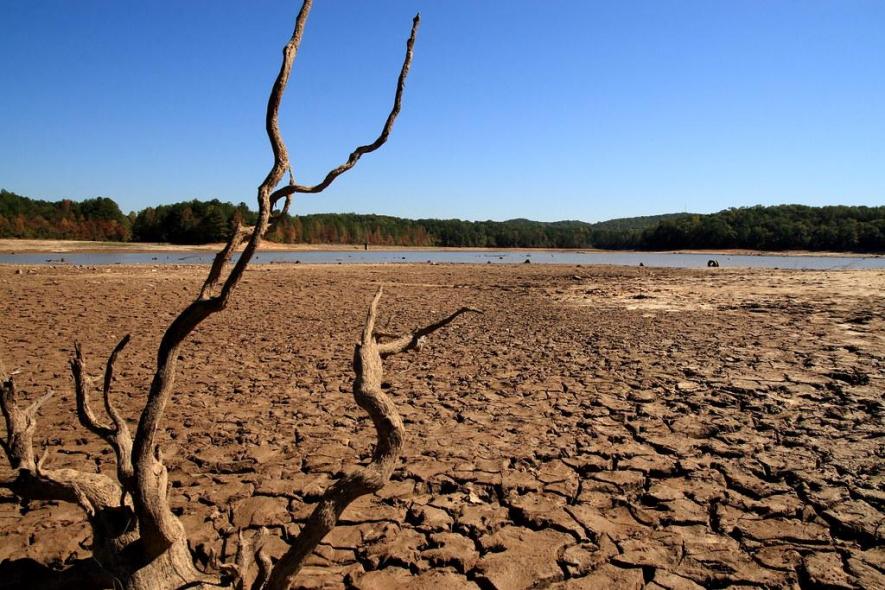Plant Processes can Make Soil Drier During Droughts

Image is for representation only, source Flickr.
New research published in Nature Climate Change on October 27 has brought in a new aspect of droughts, highlighting the importance of soil and plants' relation to it. The process called 'evapotranspiration' increases during droughts, further increasing water unavailability in the soil. In this process, the plants also contribute to increasing evapotranspiration, the research infers.
Evapotranspiration is the term used to denote a combination of two processes- evaporation and transpiration- both giving rise to water moving from the soil to the atmosphere. Through evaporation, water moves directly into the atmosphere from the soil, water bodies, and canopies. Through transpiration, water from soil moves via the root, the body, and finally, from leaves, it gets released into the atmosphere.
The Nature paper studied satellite data of precipitation and moisture below the ground and calculated the changes in the patterns of evapotranspiration during global droughts in 2003-2020. The research reveals how evapotranspiration can further amplify droughts. Meng Zhao, a post-doctoral research scholar at Stanford University and the lead and corresponding author of the study, said in a statement,
"When water is already limited, the evapotranspiration will continue to make the water loss happen even faster -- and that will make the drought more severe in a much shorter time period. We have a big challenge in predicting flash droughts, and underestimating water loss could be a major obstacle in that prediction."
Evapotranspiration is also related to the flash drought event, which develops rapidly and water depletes severely within a few weeks. Such droughts can have a profound impact on vulnerable communities and also impair food production. For example, we can cite the central great plains' flash droughts of 2012, which resulted in billions of dollars of economic losses. Importantly, India has also been identified among the global flash drought hotspots from 1980-2015.
During this period, the study finds that most flash droughts occurred in the monsoon season spanning northeast, northwest and central regions of India. The models used to predict droughts and especially their impacts, as the latest study say, will have to incorporate the crucial aspect of how plants contribute to the process. The researchers claim their study shows how incorporating the plant processes in evapotranspiration will improve Earth system models.
"We found that the model error seems to be explained by the way plants change how particles are arranged in the soil. As a result of these changes to the soil, water flows through the soil differently, changing where and how much water is available for plants to take up and transpire,"—commented Alexandra Konings in a statement which is a senior author of the study and an assistant professor of Earth system science.
"There's such a diversity of ways that plants operate that it can be really hard to understand, predict, and quantify in the models fully. And unfortunately, if this increase in evapotranspiration is happening more often than we realize, it's intensifying the effect of the drought; there's even less water in the soil than we realize because more is being lost to the atmosphere," Konings added further.
Transpiration in plants takes place via the tiny pores present in leaves that are known as the stomata. The stomata release water into the atmosphere, and plants vary in the closure of the stomata. Current Earth system models reveal that stomata are more open during droughts, around 25%, which increases evapotranspiration. But the new study found that prolonged stomata opening and increasing evapotranspiration during droughts are not limited to 25%. Rather, it happens 45% of the time. The study claims that this underestimation is larger in areas of drier climate and fewer biomasses.
The researchers combined the water storage data from the Gravity Recovery and Climate Experiment (GRACE) satellite and the precipitation data obtained from the Global Precipitation Climatology Project to calculate evapotranspiration across the globe. The study finds that drought in a particular area and developing into a higher evapotranspiration rate depends on several factors, with soil as the key. But plants also play a crucial role here, which is often inadequately reflected in present Earth system models.
Get the latest reports & analysis with people's perspective on Protests, movements & deep analytical videos, discussions of the current affairs in your Telegram app. Subscribe to NewsClick's Telegram channel & get Real-Time updates on stories, as they get published on our website.














